Piloting Change Takes Time, Tweaking, and Patience
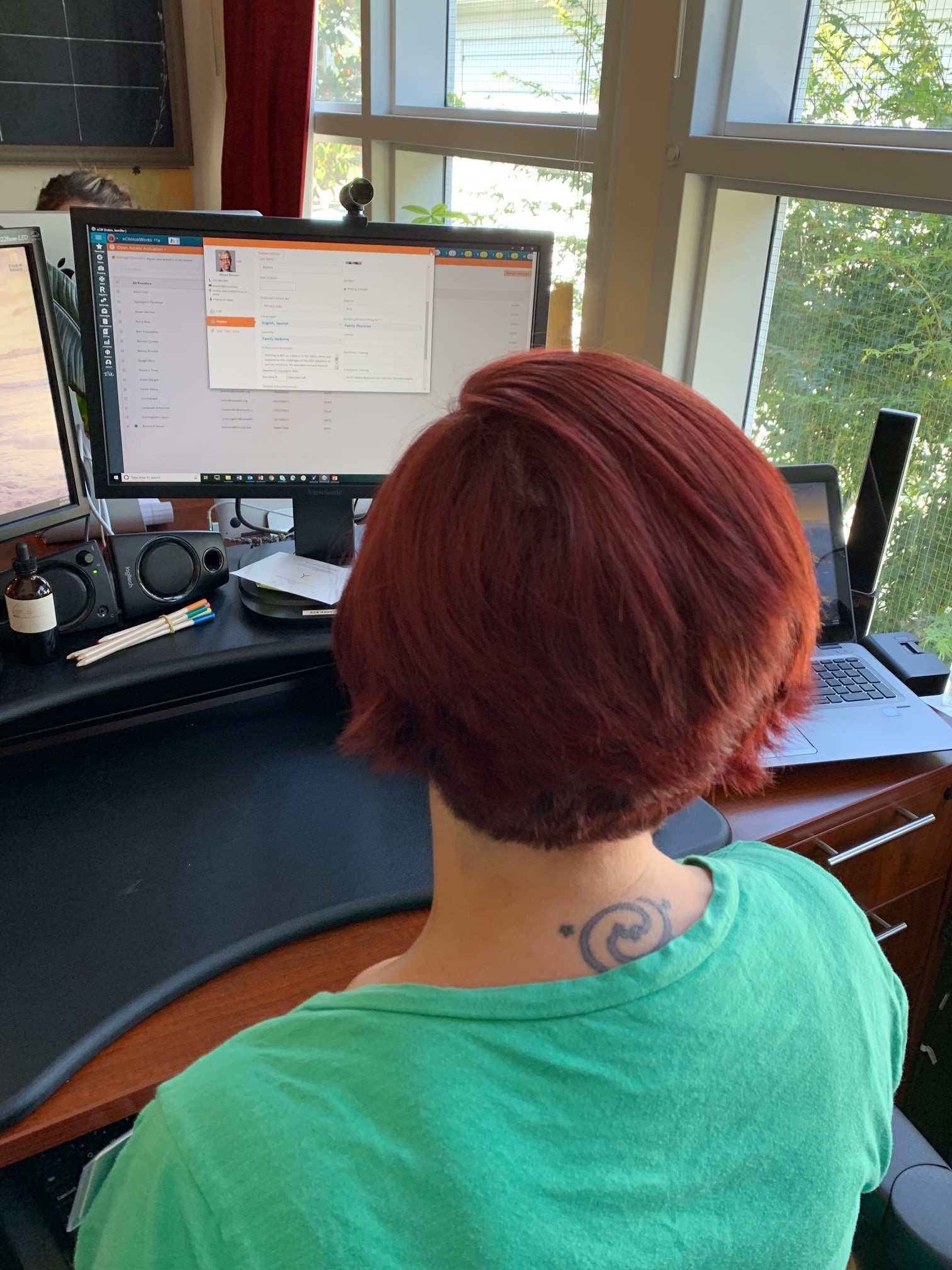 West County has an admirable track record of thoughtfully transitioning to new technology. It has partnered with Hitch Health to address transportation insecurity. (Read our case study on WCHC’s partnership with Hitch Health to learn more.) It also introduced video visits long before the coronavirus pandemic made telehealth appointments routine. It favors a small-scale, two-pronged approach to pilot programs involving digital innovation to uncover tech kinks or human obstacles while rolling out a new online service. It also understands that sometimes these programs start with slow adoption rates but pick up steam as both staff and patients become more comfortable with change, says WCHC’s director of IT Summer Penn.
West County has an admirable track record of thoughtfully transitioning to new technology. It has partnered with Hitch Health to address transportation insecurity. (Read our case study on WCHC’s partnership with Hitch Health to learn more.) It also introduced video visits long before the coronavirus pandemic made telehealth appointments routine. It favors a small-scale, two-pronged approach to pilot programs involving digital innovation to uncover tech kinks or human obstacles while rolling out a new online service. It also understands that sometimes these programs start with slow adoption rates but pick up steam as both staff and patients become more comfortable with change, says WCHC’s director of IT Summer Penn.
Take online appointments. The traditional patient appointment booking model has its difficulties for both staff and patients. Scheduling phone appointments can be a time-consuming task with extended wait times when call volume is high, which can stress staff and frustrate patients, especially those forced to listen to endless loops of on-hold music. The average phone call to schedule a medical appointment reportedly takes eight minutes; a third of that time is spent on hold.
In addition, not every patient is able to call during conventional business hours – 9 a.m. to 5 p.m. – especially when medical clinics adhere to a practice of shutting off phones from noon to 1:30 p.m., as WCHC does, to accommodate staff lunches and dedicated work time. In contrast, a 24/7 online booking platform is efficient and allows patients to feel in control of their healthcare. Further, patients may be more willing to convey their health needs more fully and honestly via an online platform, with anonymity and privacy assured, rather than talking with a clinic staffer or call clinic representative.
Showing up to book in person is an option, but not particularly practical in a rural setting, especially one with high transportation insecurity. Leaving an online portal message is another possibility, but it still requires a staff member to call back and a round of phone tag may ensue. None of these options are particularly helpful to a working person who may struggle to find time to contact the clinic during business hours.
In contrast, an online booking platform such as healow gives patients the freedom to schedule doctors’ visits whenever and wherever is convenient for them. “As a working mom, I recognize that we are unable to offer phone booking access when we believe patients need it,” says Penn. “By adopting this tool, we are expanding access for patients so they can make or change appointments as they need to on their own time.”
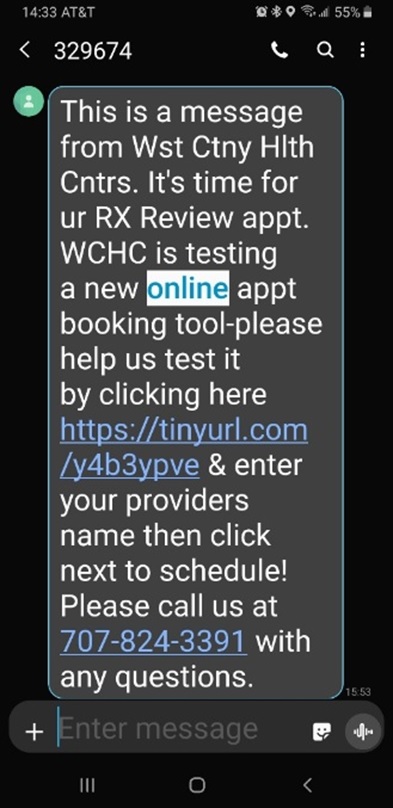
In the first pilot, West County tested the booking tool through its eClinicalWorks workflow as part of a routine medication review. Forty-three patients received a message to book their prescription drug check via the clinic’s patient portal, text, and/or email. The communication included a link or “Book Now” button for patients to click on to schedule an appointment. That link takes patients to an online web-based site where they search for their primary care provider, find an appointment time, and book themselves directly onto the eClinicalWorks schedule. Throughout the process, the patient receives email communication about the status of their booking, request, and confirmations.
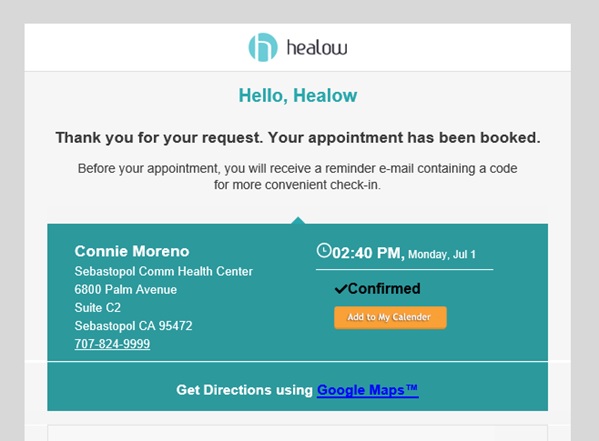
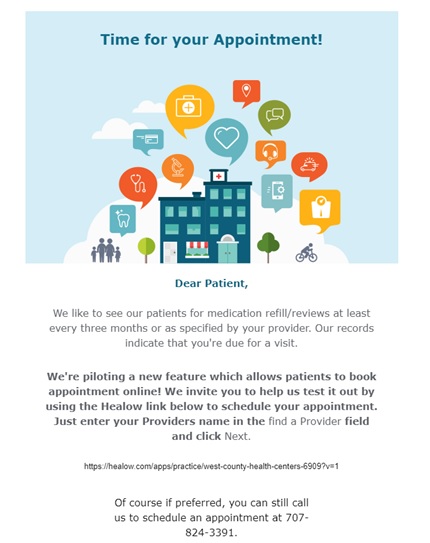
Prior to COVID-19, patients who made appointments this way received a reminder message two to seven days before their scheduled in-person appointment. Patients also receive an old school reminder telephone call 24 hours prior to their appointment via a care representative, regardless of whether they had confirmed via text message. Just four patients or 9 percent of the cohort opted to try the new online option, a lower opt-in rate than anticipated.
The second pilot, which involved 35 patients and followed a similar pathway, was designed for patients to book their annual exam with one specific provider. Just two patients, or 6 percent of the group used the online option. At first, WCHC staff were a bit surprised they had so few takers to the new system, which the clinic attributed, in part, to not doing any education or marketing around the new tool prior to the pilot. But according to eClinicalWorks, healow’s online appointment booking service usually takes time to be accepted, even when full-scale marketing and education campaigns accompany its roll out.
Penn says the low adoption rates could also be caused by what she calls tech skepticism. “Some patients worry that if they submit something online it may not actually go through. Others wonder if it’s some kind of scam and are reluctant to click on a URL that pops up on their phone,” she explains. “Some just like the comfort of talking to a live person. We are known for our relational care: Our patients come back to us because of the personal relationships they have with clinic staff. There’s an ease and comfort to that.”
Despite the small nibbles for the service, Penn is confident WCHC can adopt such efficiencies more widely down the track at a date to be determined — given the current pivot due to the pandemic — without compromising care. She points to widespread acceptance around the country as evidence that online booking is here to stay.
Studies Find Booking Online Both Popular and Effective
Indeed, online medical appointments are growing in popularity. A review of 100 large healthcare systems revealed that 40 percent of patients are able to schedule an appointment online, according to a 2016 study by Accenture, a global professional services corporation with a focus on digital innovation. Further, 77 percent of patients said that it is important for them to be able to book, change, or cancel appointments online with their healthcare provider. In the same analysis, Accenture predicted that by the end of 2019, 66 percent of US health systems would offer digital self-scheduling and 64 percent of patients would book appointments using digital tools. And, despite the stereotypes, it’s not just Millennials who do everything online: Boomers are comfortable booking on the web, too.
Consumers want such services and providing them can not only increase efficiencies but give clinics a competitive edge. According to an earlier survey by Intuit Health, a developer of patient portal and communication technology, 81 percent of patients would schedule a doctor’s appointment online if they could, and 40 percent of patients would consider switching providers for online access.
Research from 2017 by the online medical care scheduling service company Zocdoc found that new patients who booked appointments online waited just 7.6 days to be seen, versus the national average of 24.1 days. Further, 11 percent of new patient appointments booked on the same calendar day, 40 percent within the next three days, and 79 percent of patient searches found at least one available time slot in the next three days—filling open slots alleviates a pain point for many clinics.
When patients can book online appointments, they can do so at their leisure during off hours that suit their schedules. Meanwhile, staff that would typically be fielding calls are freed up for other clinic tasks, such as follow up calls with existing patients and handling new patient requests.
Being able to book appointments online with their healthcare provider is absolutely key in keeping up with the continuity of care for West County Health Centers patients, says WCHC care team representative Tristan Turner. Besides being quick and convenient, “it makes healthcare more accessible, bringing it to the patient’s computers and mobile devices.”
Lessons Learned
The WCHC IT team ran into some significant challenges trying to implement the service. Here is their advice for other teams rolling out an online booking tool:
- Patients need to be able to specify the type of medical visit they need. For instance, healow doesn’t yet include a function that allows patients to specify the type of visit, such as annual exam or urgent care, in dropdown options that, Penn says, are vital for both patients and staff to avoid confusion and to ensure appropriate scheduling. For the platform to truly serve patients and staff, Penn says, it needs to offer categories such as annual medical, urgent care, follow up, medication review, and general office visit. She has been communicating with the company about this shortcoming and looks forward to it being addressed.
- Online booking tools should take into account clinic workflows. Snafus around appointment times and clinic workflows can cause confusion. A typical office visit at WCHC is 20 minutes, so care staff would ordinarily book appointments at 9 a.m., 9:20 a.m., 9:40 a.m. and so on. But initially the online platform allowed patients to book whenever — so, say at 9:10 a.m.. Penn found a workaround to that through what is known as visit type rules. In the same vein, the IT crew could employ visit type rules to specify what kind of visits were available when, to avoid, for instance, a doctor having a day full of only annual exams with no slots for, say, urgent care.
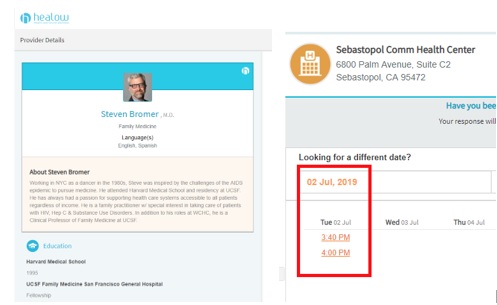
- Get staff buy-in early on. It was important to gain staff buy-in by communicating the benefits of introducing such a system. No staff members want to feel like they might be out of a job with the implementation of a new technology, notes Penn. Care team members at WCHC now appreciate that when patients are able to control scheduling their own appointments, it frees them up to focus on helping patients in other ways. Testing technology can be a major financial outlay, too, so it’s important to build a culture around e-communication tools to encourage adoptability of new technology, says Penn.
- Find time for employee training. On the staff side, as with all new innovations, training is key. The IT crew found that walking care team representatives through the system one-on-one to reinforce the program and answer any questions or concerns on the spot helped alleviated any concerns or reservations about the new platform.
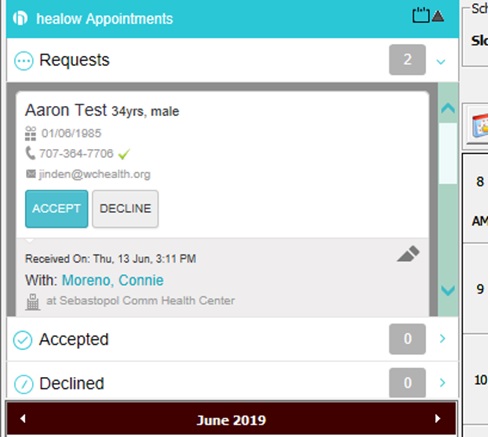
Next Steps
In the age of COVID-19, the pilot program, wrapped up in the summer of 2019, seems like a lifetime ago. Penn says the implementation of online appointment booking for in-person visits is largely on pause due to the pandemic. But it is being used for a small group of patients who prefer to have virtual video appointments with a doctor, versus conducting a visit over the telephone. And Penn plans to gather feedback about how that’s working out for all parties.
Penn says there are reasons beyond convenience and efficiency to integrate online booking into a practice. Patients may be more honest about why they want to see their doctor if they book online. They may, for instance, provide more detailed descriptions of their symptoms, especially if they feel embarrassed to describe them over the phone. Through an online appointment booking system, patients can provide a more accurate description of what and how they are feeling. In turn, this can help clinicians be better prepared for their visit.
These efforts to streamline bookings for patients haven’t gone unnoticed. “I appreciate that WHC is trying to make it more convenient for me to make appointments and access my doctor,” said one patient. “It’s hard to get through to call during specific hours of the day. Booking myself makes it easy.”
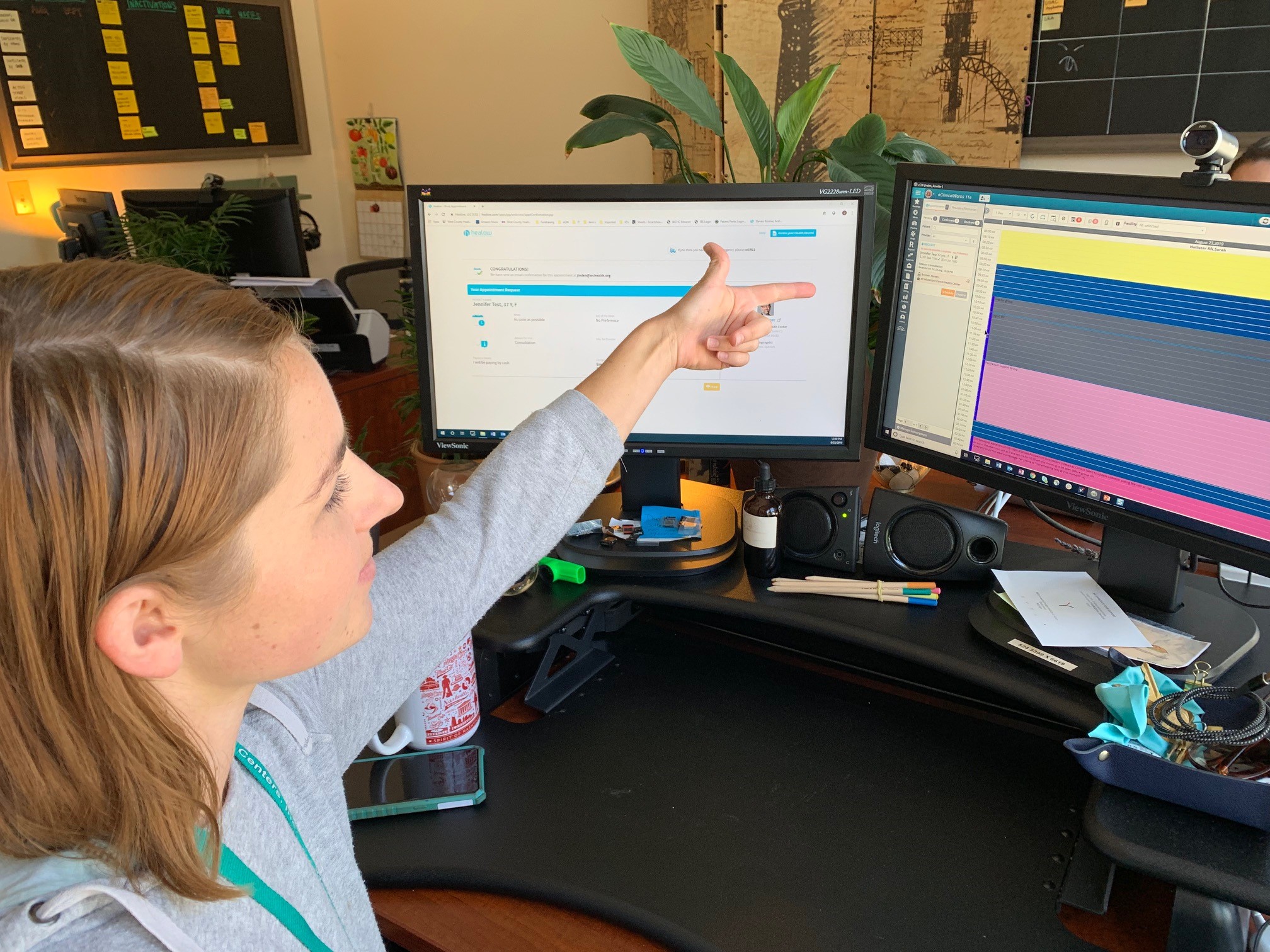

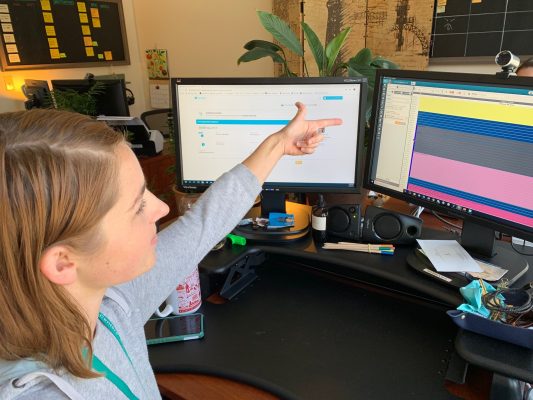

 West County has an admirable track record of thoughtfully transitioning to new technology. It has partnered with
West County has an admirable track record of thoughtfully transitioning to new technology. It has partnered with 



